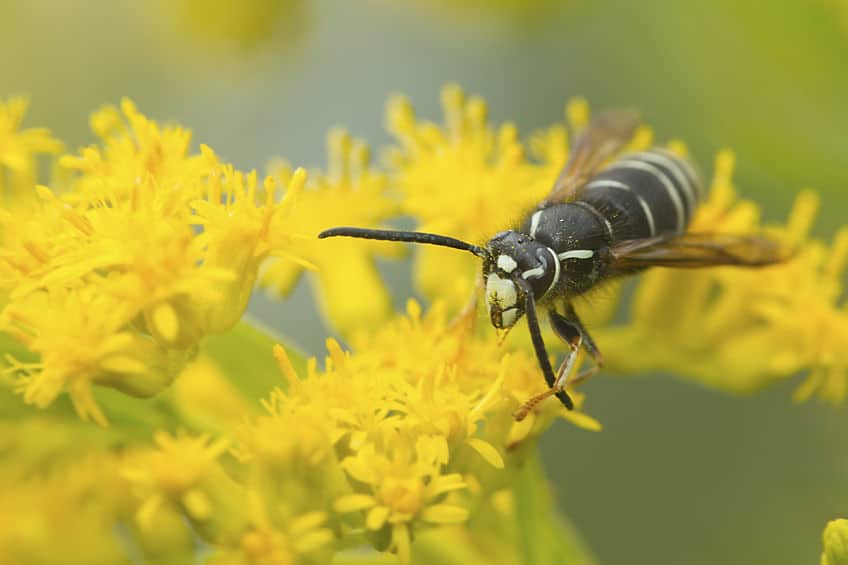The bald-faced hornet, Dolichovespula maculat, is also known as the black-jacket and the bull wasp. They are found across North America. Despite its common name it is from the Vespula family and is not a true hornet. You will find some of the most common questions about the bald-faced hornet answered below.
How did the bald-faced hornet get its name?
They are not named because they lack hair but because of a piebald appearance. They have a white face which gives them a piebald look or in other words a black and white appearance. This distinguishes them from other Vespula wasps which often have the distinctive yellow and black look. This along with their larger size and their aerial nests may explain why they are referred to as hornets despite not being true hornets.
Do bald-faced hornets make nests underground?
They make aerial paper nests with colonies of up to around 700. They mostly nest in trees but are known to nest on the side of houses. Due to their potentially aggressive behavior around the vicinity of the nest, it is common practice to have the nests removed when too close to built-up areas. They will sting repeatedly in defense of their nest and are notably aggressive.
Do bald-faced hornets reuse their nests?
They do not typically reuse their nests and the queens will make new wasps each autumn. Bald-faced hornets typically steer clear of other wasp nests whether active or not. This makes sense as they would not want to compete over territory and resources. All the wasp from a previous colony, including the queen die each winter, with only a new queen hibernating over winter. Some wasp species may reuse nests such as metricus wasps. But this is unusual.

Can bald-faced hornets spray venom?
The sting isn’t the only concern with these wasps. Like some other wasp species, including murder hornets, they can spray their venom. This tactic evolved to counter threats from mammals such as bears. Due to this development, they will target the venom towards the eyes and it can be a significant irritant and may cause temporary blindness (source).
Do bald-faced hornets have painful stings?
The entomologist Justin Schmidt ranked the bald-faced hornet as having a relatively moderate sting compared to other insects but that is not to say it isn’t painful. As they are a social wasp the chance of being stung more than once is highly likely and so the pain can be compounded. In his insect pain index, he gave it a rank of 2 out of a possible 4. He described the sting as ‘Rich, hearty, slightly crunchy. Similar to getting your hand smashed in a revolving door.’
Do bald-faced hornets have queens?
Like many other social wasp species the colony is founded and dependent on a single queen. The queen is inseminated before going into hibernation and will search for a new site to establish a colony in the spring. It is estimated that up to 99.9% of queens do not survive winter. Go here to find out more. The queens that do survive have no easy life. She must begin building the nest alone and she must hunt for food to feed the first brood. Once established she will become an egg-laying machine, producing almost all the eggs in the colony, and may never leave the nest again.
Can bald-faced hornets survive winter?
Bald-faced hornets like other species can not survive in cold weather. Only the new batch of queens will seek to hibernate. The old queens along with all the workers will die at the onset of winter. Males have a shorter life than females as once they inseminate the new batch of queens their roles cease, so they may only live for a few weeks at most. Female workers live for a few months at most. Read more.
Do bald-faced hornets bite?
Bald-faced hornets can bite using their mandibles although the bite can not in itself do much harm to people. The mandibles, while mouthparts are more akin to claws than teeth. They may use their bite to get a purchase in order to inflict a sting. Their principal defensive weapon is their sting so in order to get purchase they often grab onto its target with their mandibles. Their mandibles are also used when hunting and can decapitate many insects.
Do bald-faced hornets eat flies and bees?
Bald-faced hornets will prey on both flies and bees. They primarily use their mandibles to kill these insects. They chew them in their mouths but rather than swallowing them they take them to their nests where they spit the chewed-up insect into the mouth of the hungry wasp larvae. While bald-faced hornets do attack bees they do not actively target bees’ nests but are more likely to pick off individual bees. Murder hornets by contrast do actively target and attack beehives. Read more about wasps attacking bees here.
Do bald-faced hornets pollinate?
Bald-faced hornets do pollinate. The adults feed primarily on nectar from plants and as such spend considerable time flying from flower to flower just like bees do. In the process they pollinate plants. Read more about wasps and pollination here.
